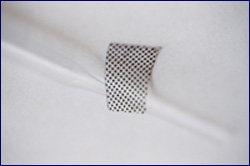Materials Sciences
Materials management deals with the research, development, manufacturing and processing of raw and industrial materials. Key aspects here are biological and medical issues, which play an increasingly important role in this field.
innovations-report offers in-depth articles related to the development and application of materials and the structure and properties of new materials.

Space suit technology can protect workers from heatstroke
The technology used in space suits to protect astronauts carrying out space walks in direct sunlight is now being used to develop protective clothing to safeguard firefighters and steel workers who often work in extremely hot and dangerous conditions.
“The existing protective clothing used while performing physically demanding work in hot conditions can, in many cases, hinder workers’ ability to remain cool,” explains Stefano Carosio from the Italian company D’Appoloni

’Nano skins’ show promise as flexible electronic devices
A team of researchers has developed a new process to make flexible, conducting ’nano skins’ for a variety of applications, from electronic paper to sensors for detecting chemical and biological agents. The materials, which are described in the March issue of the journal Nano Letters, combine the strength and conductivity of carbon nanotubes with the flexibility of traditional polymers.
“Researchers have long been interested in making composites of nanotubes and polymers, but i

Mixed conductor ceria proven as excellent catalyst for fuel cell anodes
Researchers at the California Institute of Technology have discovered that ceria (or cerium dioxide) is an excellent catalyst for fuel cell anodes. This discovery was made through careful electrochemical characterization using a.c. impedance spectroscopy, an important tool for studying the electrical transport behavior of ceramics. The study is published in the Journal of the American Ceramic Society.
By applying an a.c. electrical voltage to the ceria (a white crystalline p

MIT thinks small to find safer metals
MIT researchers have devised a new method for shrinking the size of crystals to make safer metal alloys. The new materials could replace metal coatings such as chromium, which is dangerous for factory workers to produce.
The method, developed by Associate Professor Christopher Schuh and graduate student Andrew Detor, both of the Department of Materials Science and Engineering, involves making the crystals within an alloy (a combination of two or more metals) smaller and thus hard

The nanoworld of corrosion
The effect of corrosion has an impact on about 3% of the world’s Gross Domestic Product. From a positive point of view, however, chemical attack of metal surfaces may result into surface nano-structures with very interesting technological applications such as catalysts and sensors. Therefore, a better understanding of corrosion processes is required to both prevent it and make the most of it. Scientists from Germany and the European Synchrotron Radiation Facility (ESRF) have highlighted a self-

Adding nanotubes makes ordinary materials absorb vibration
New composites could remove buzz from speakers, sting from golf clubs
A new study suggests that integrating nanotubes into traditional materials dramatically improves their ability to reduce vibration, especially at high temperatures. The findings could pave the way for a new class of materials with a multitude of applications, from high-performance parts for spacecraft and automobile engines, to golf clubs that don’t sting and stereo speakers that don’t buzz.
The mate